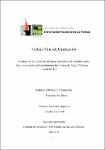Evaluación del efecto de distintas densidades de siembra sobre los componentes del rendimiento del cultivo de trigo (Triticum aestivum L.)
Metadatos
Mostrar el registro completo del ítemResumen
El trigo ocupa un lugar importante en las rotaciones de cultivos que se realizan en los campos de la región pampeana. En base a éste se elaboran varios alimentos que integran la canasta básica en la dieta de los argentinos. De las decisiones de manejo la elección de la densidad de siembra es fundamental ya que constituye un 21% del costo directo del cultivo. Varios ensayos se han realizado hasta la actualidad sobre la densidad de siembra óptima para este cultivo encontrándose resultados dispares. El presente trabajo se realizó en el establecimiento Nueva Castilla, perteneciente a la empresa Eduardo Pereda y Hnas. Agropecuaria S.A, durante la campaña 2016/17. En el mismo se evaluó la respuesta agronómica del cultivo a las diferentes densidades de siembra, y como ésta afecta a los componentes del rendimiento: plantas/m2 , espigas/m2 , PMG, PH y por último al rinde. El rendimiento, las espigas/m2 y el PMG no resultaron afectados por las diferentes densidades, en cambio sí resultaron afectados los vástagos/m2 y el PH. Los vástagos/m2 al aumentar las densidades fueron disminuyendo, efecto causado por la plasticidad que posee el cultivo de trigo, en cambio el PH no presentó una tendencia clara al variar la densidad. En conclusión, el rendimiento no varió significativamente al variar la densidad, lo cual puede explicarse por la compensación de los componentes que hacen al rendimiento, algunos de estos como los vástagos/m2 fueron los que tuvieron mayor respuesta al variar el stand de plantas. Esto comportamiento indicaría que podría ser posible reducir los costos del cultivo al reducir la cantidad de semilla empleada. The wheat occupies an important place in the crop rotations that made in the fields of the Pampas region. Based on this, several foods elaborated and that make up the basic basket in the diet of Argentinians.From management decisions, the choice of sowing density is fundamental since it constitutes 21% of the direct cost of the crop. Several trials have been realized up to date on the optimum sowing density for this crop, finding different results.The present work realized out in the 'Nueva Castilla' establishment, belonging to the company E. Pereda y Hnas. Agrop. SA, during the 2016/2017 season. The agronomic response of the crop to the different sowing densities evaluated, and how it affects the yield components: plants/m2 , ears/m2 , TGW, test weight and finally to the yield.The different densities did not affect the yield, the spikes/m2 and the TGW; however, the shoots/m2 and the test weight were affected. The shoots/m2 when increasing the densities were decreasing, effect caused by the plasticity that the wheat crop has, however the test weight did not present a clear tendency when varying the density. In conclusion, the performance did not vary significantly when varying the density, which explained by the compensation of the components that make the performance, some of these as the shoots/m2 were the ones that had greater response to vary the stand of plants. This behavior would indicate that it might be possible to reduce the costs of the crop by reducing the amount of seed used.
Autor/a
Allemandi, Evangelina
Capozzi, Emiliano
Director/a
Fernández, Miguel Angel;
Riestra, Diego René (jurado)
Zingaretti, Osvaldo (jurado)
Zingaretti, Osvaldo (jurado)
Fecha
2018Tipo de documento
tesis
Subtipo de documento
trabajo final
trabajo final
dc.language.iso
spa
Palabras clave
Trigo; Rendimiento de grano; Dosis de siembra;
Keywords
Wheat; Grain yield; Sowing rate;
Materias
Agricultura : : Cultivos : : Cereales;
Utilizar el siguiente identificador (URI) para citar o enlazar este registro:
https://repo.unlpam.edu.ar/handle/unlpam/1385Registros en colección
- Tesisg [1868]











